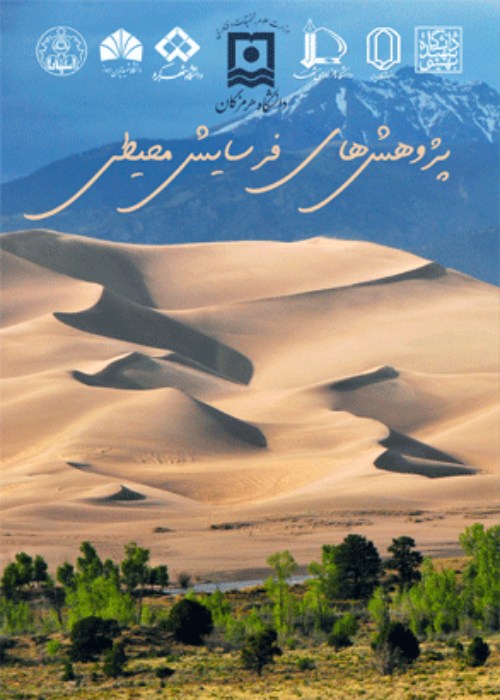Identification of Storms and Centers of Dust Production in Southeast of Iran (Case Study: Sistan Region)
Wind erosion is affected by climate change and several droughts have caused environmental degradation in arid regions. This process causes sand and dust storm (SDS) phenomenon which is one of the most important challenges in fragile areas. This phenomenon is harmful for human health and causes socio-economic problems. Over the past two decades, SDS have been increasing in Iran, particularly in the south-east of the country. Therefore, in order to manage this environmental phenomenon in arid areas, it is an urgent need to identify the dust storm sources. The changes of factors such as vegetation, soil moisture, slope, land temperature, and geological units have effective roles in the occurrence of dust storms. So, investigating the changes in these factors is an effective solution to identify dust storm sources. In this regard, using remote sensing data is one of the effective methods for the detection and mapping of dust storms resource, which combined with field methods, provides a coherent approach to manage and control this phenomenon. This study aimed to identify dust sources and storms in the southeast of Iran with emphasis on the Sistan dust storm by using field work and remote sensing data.
The study area is located in the south east of Iran and contains some of the border areas of Iran and Afghanistan (including some parts of the south Khorasan and Sistan and Baluchestan province in Iran as well as Farah and Nimroz province in Afghanistan with coordinates of 60˚ 16′ - 61˚ 36′ east longitude and 29˚ 8′ - 32˚ 32′ north latitude). In north of the study area, the mountainous and low-altitude areas are intertwined but the southern area is mostly flat and lacks topography and natural features. The most important characteristics of this area is 120-day winds, which sometimes reach speeds of more than 120 kilometers per hour and is accompanied by high intensity of sand and dust storms. In this study, to identify dust storm sources, the combination of remote sensing, field study and wind analysis methods are used. To achieve this purpose, at first effective factors in the occurrence of dust storms such as vegetation, soil moisture, slope, land temperature, and geological units were prepared. In this regard, by using Modis satellite images, map of vegetation, soil moisture and land temperature were prepared by applying Soil Adjusted Vegetation Index (SAVI), integrating temperature vegetation dryness index (TVDI) and Land surface temperature (LST), respectively. Also slope map (using Aster satellite) and geological units were prepared. In the next stage, the fuzzy logic method was employed to combine layers and prepare the map of dust storms source, which is assessed by an error matrix and available dust source map. Detection of sand dust storms were performed by using BTD dust detection indicator. For winds analysis, we used WRplot view 8 Software. In the field study, several dust storms sources were determined and their characteristics were recorded.
The results showed that the ranges of SAVI index are + 0.6 to -1 and the highest amount of this index coordinate with highest soil moisture (TVDI) and the lowest land surface temperature (LST) area. This area is mostly related to rangeland, combination of wetland-rangeland, hand-planted forests and agricultural lands. The amount of SAVI index and soil moisture reaches its minimum value in the salt marsh lands, abandoned agricultural lands, desert areas and degraded rangeland. By merging the layers and preparing the map of dust storm sources, it was found that the critical dust storms resources coordinate with high land surface temperature and low vegetation and soil moisture areas. In addition, the highest dust source area is in the slopes of 0 to 4 % with geological units such as playa deposits, eolian deposits, alluvium sediment and wet playa deposit. According to the results, the incoming dust storms into the study area come from the east and southeast of south Khorasan province in Iran and the southwest of Farah province in Afghanistan.
In this study by using effective factors including vegetation, soil moisture, land surface temperature, slope and geological units, the sources of dust production were identified. According to the results, poor vegetation and low soil moisture in flat areas with sensitive formations are the key factors to create dust storm resources in the study area. Also, the most important active hot-spot areas for dust storm is concentrated in the southwest of Afghanistan and north of sistan region (dry lake bed of Hamoon). Therefore, it can be concluded that using satellite images and the studied factors, the dust sources can be properly identified. Furthermore, by using Time series images of modis and the updated dust source maps, a coherent approach can be provided in order to manage and control this phenomenon.
- حق عضویت دریافتی صرف حمایت از نشریات عضو و نگهداری، تکمیل و توسعه مگیران میشود.
- پرداخت حق اشتراک و دانلود مقالات اجازه بازنشر آن در سایر رسانههای چاپی و دیجیتال را به کاربر نمیدهد.


